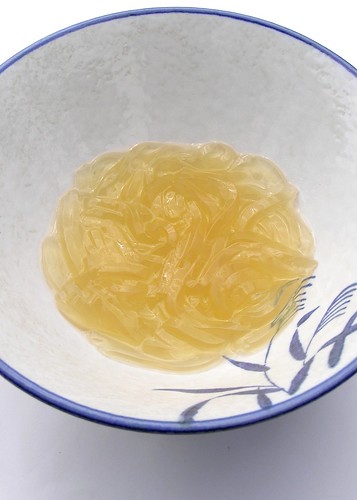
Day forty-seven: Kuzu Kiri / 葛切
Oimatsu
Similar to kanten-based tokoroten, kuzu kiri is a hot weather treat of gelatinous noodles served chilled with a sweet sauce. Although other, cheaper starches are sometimes used, the best kuzu kiri are still made of the powdered root of the kudzu vine. The best kuzu reputedly comes from the mountainous area around Yoshino in Nara Prefecture, not too far from Kyoto, where sticky summer weather ensures a ready market for kuzu producers.
In wagashi shops, kuzu kiri is most often sold inside a long rectangular container; a bar of kuzu jelly sits inside the plastic or wood box that is open at one end and covered with a grid of horizontal and vertical wires or plastic bars at the other. When the customer is ready to eat the kuzu, he or she fits the plunger provided into the top of the box and pushes down, extruding the square-sectioned kuzu noodles into a bowl. The package also includes an envelope of syrup (black sugar, plum, green tea, etc.) that can be squeezed directly onto the noodles or used for dipping. The plum-flavored example above, from Oimatsu, was tart and a perfect balance of soft and chewy.
The Kagizen Yoshifusa tearooms in Kyoto's Gion area serve a variety of treats but specialize in kuzu products. Heading back to the tables you pass through a curtain decorated with a kuzu kagi, a tool for harvesting kuzu, and an alcove display of huge kuzu roots and other associated tools of the trade. Kagizen Yoshifusa's kuzu kiri are thick and irregular, cut by hand. They arrive at the table in tall, lidded lacquer bowls full of cold water; the pale, translucent noodles swirl against the black lacquer like a swarm of jellyfish. The noodles are served with an accompanying bowl of black sugar syrup that is as viscous as tar and tastes of minerals.


No comments:
Post a Comment